Click on arrow, then on the little box in the lower right corner for a full-screen slide show of my photos taken at Nelson Lake:
I do miss visiting the local Bald Eagle nest in Pembroke Pines, Florida. Those frequent short trips to the eagles’ territory usually yielded great views of the majestic raptors. Their first chick fledged 66 days ago, on May 4, and the second left the nest two days later. Although they soon flew freely and effortlessly and by now have surely developed their hunting instincts, they continued to return to the nest for occasional feedings from the parents– that is, until May 22, after which Hope, the older eaglet, suddenly disappeared. At about the same time, the adult female disappeared, leading us to speculate that they may have migrated together. As of this writing, it appears that Justice, who was last observed being fed at the nest on May 30, was last seen on June 4, along with one remaining adult. For the latest information on the eagle nest, tune into the eagle-watchers’ observations and photos in this FORUM.
Unlike songbirds that fly south in winter, the timing and direction of migration of Bald Eagles varies quite a bit. Those from Canada and the northern tier of the United States tend to winter to the south, but only as far as necessary for them to find open water for fishing. Southern eagles, which lay their eggs in the dead of winter and fledge before the beginning of summer, usually move to the north during the hot summer. We can only speculate as to where the locals birds are wandering. Eagles from more southerly nests at the tip of the Florida peninsula tend not to fly great distances on migration, staying generally south of Lake Okeechobee. More northerly eagles move up the Atlantic coast, often to Maryland and Virginia, where they have been known to congregate on Chesapeake Bay. The Pembroke Pines birds are actually in between these two geographic distributions. Without radio tracking and/or colored bands, there is no way of knowing where they are.
We just hope that the adults continue the usual pattern of returning to their territory around October or November to refurbish their nest and prepare for egg-laying in mid-December. By then, we hope that the official designation of their territory as a City of Pembroke Pines Bald Eagle Sanctuary will have been accomplished.
Here in Ilinois, we see many birds that are transitory or scarce in Florida. Just after dawn on June 5, we hurried to Nelson Lake Marsh/Dick Young Forest Preserve in Batavia, Illinois, about 2 miles from our home. We entered by way of the newer north entrance, from which a paved path leads past a wetland area into extensive tall grasslands, hoping to see some species that favor such open spaces. We were not disappointed.
The Field Sparrow is usually shy and retiring, but this one posed nicely along the path:
An Eastern Meadowlark sang carols from the top of a small oak tree:
As we watched a tiny Grasshopper Sparrow in a small bush, it surprised us by flying towards us and landing on a gravel path:
Before it took off, the sparrow stretched up, casting an over-sized early morning shadow: 
Dicksissels were abundant, and this one looked especially colorful in the harsh morning light:
Numerous Song Sparrows sang from the tops of shrubs killed by controlled burns that rejuvenated the grasslands:

I could not resist taking a photo of a goldfinch hiding among the goldenrods:
The cool end of the color spectrum was represented by this Indigo Bunting: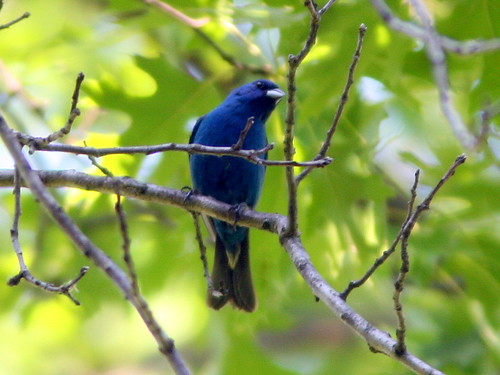
This morning, Mary Lou and I returned to Nelson Lake for a pleasant two-hour walk. This time we came in the east gate, where the habitats varied from open grassland to second growth hardwood woodlands. The skies were overcast, and it was cool (by Florida standards) 61 degrees with little wind. We walked leisurely along the southern perimeter of the lake, taking in the songs of local resident birds: scores of Common Yellowthroats, robins, catbirds and goldfinches, and at least a dozen Swamp Sparrows. The latter stayed out of sight as their loud trills filled the air. Also invisible were a Marsh Wren and several Sedge Wrens. Several Turkey Vultures tilted above. A Brown Thrasher sang vigorously. At first I thought I was hearing a mockingbird, as this thrasher violated the norm by often repeating the same melodic phrases more than twice, even launching into a stanza of variations on a single series of tones, repeating it even five or six times.
A Yellow Warbler with particularly bright plumage greeted us this morning:
This Baltimore Oriole competed for the distinction of being the bird with the most brilliant coat:
As we were walking back to the parking lot, a large dark bird rose up from near the edge of the lake. At first we almost dismissed it as another vulture, but many hours of eagle-watching back home paid off, as we both recognized the familiar shape of a Bald Eagle: long narrow wings held out flat, elongated head and neck, and substantial fanned tail. The lighting conditions were so poor that we were uncertain as to whether it had the all-white head and tail of an adult. Seeing the eagle made us suddenly feel closer to our eagle-watching friends in Florida.
Back home, my photos (with apologies for their poor quality) confirmed that the eagle was at least four or five years old, as its head and tail were pure white:













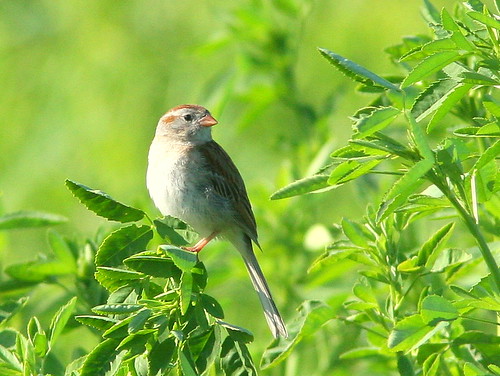
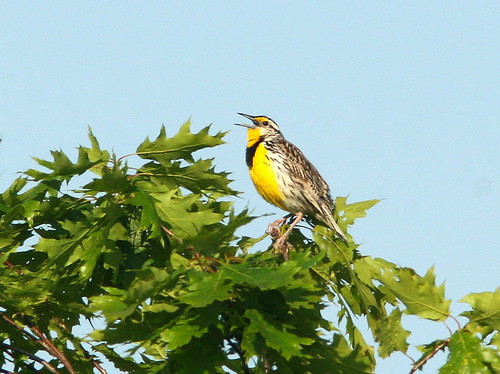
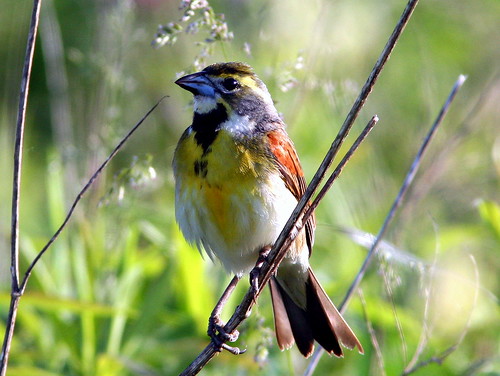

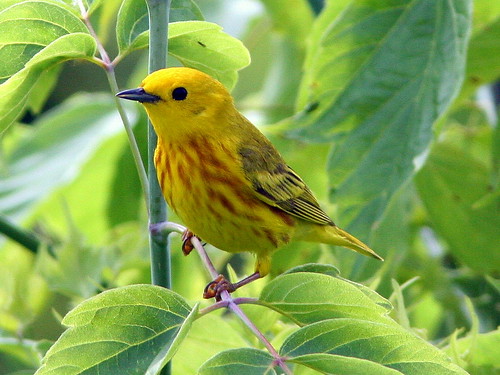
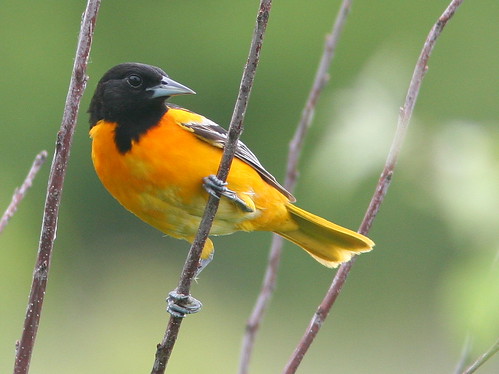

June 11th, 2009 at 11:45 am …beautiful photos and such a nice variety of birds too!
June 11th, 2009 at 7:43 pm Hello Ken very nice pictures, it is great to hear about the pembroke pines eagles and to hear others share their love of the environment. I agree with you that we do need to preserve our environment and its inhabitants. We need to educate others to preserve the plants and wildlife in our area. This is one of the things that prompted my husband and I to move to this area. I would be greatly sadened to loose any of the birds and plants that we enjoy here. I will continue to post, when I can, on the eagle forum.
June 12th, 2009 at 7:29 am Great composition, lot of details and very crisp. Love t, and thanks fr sharing